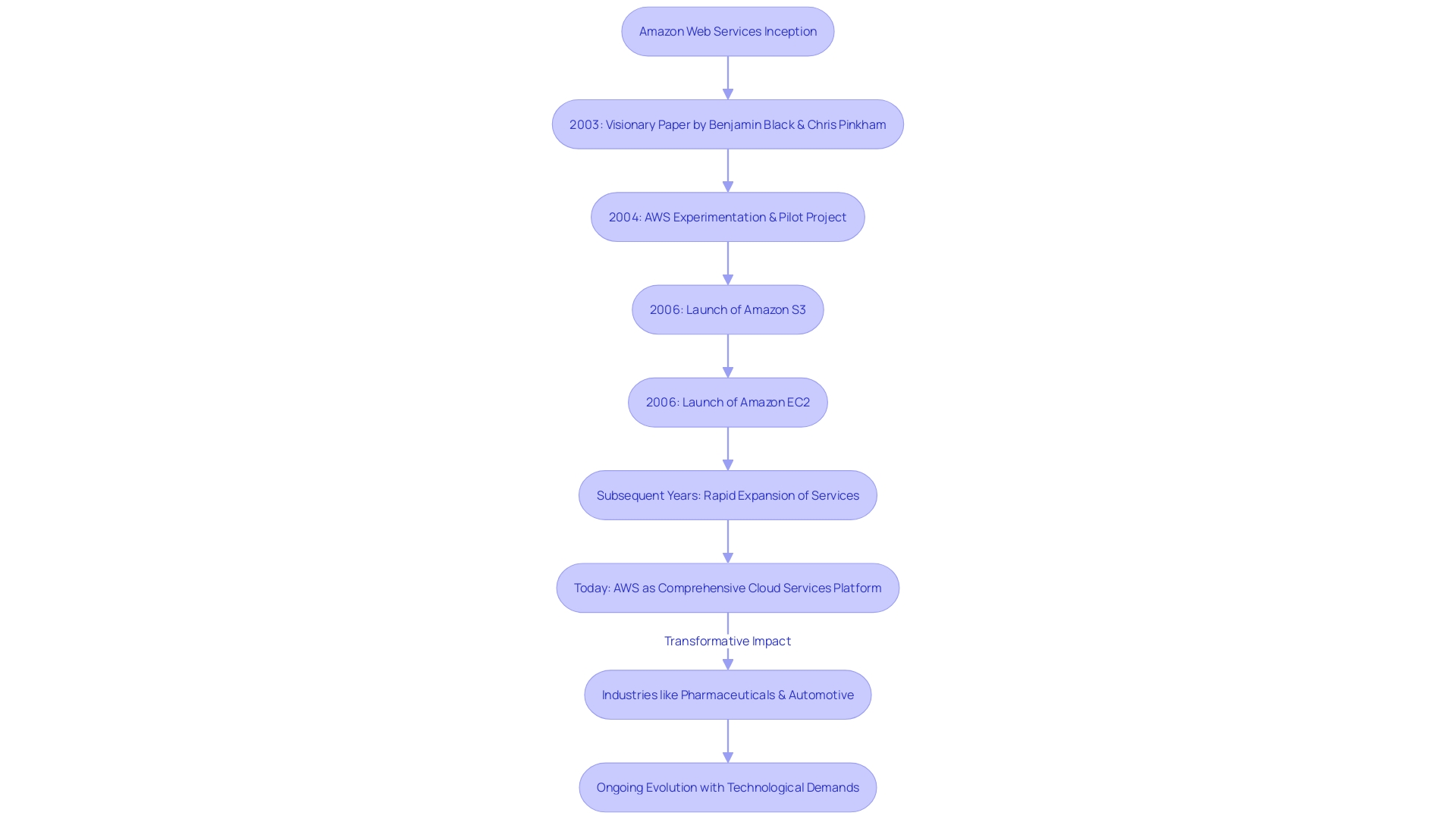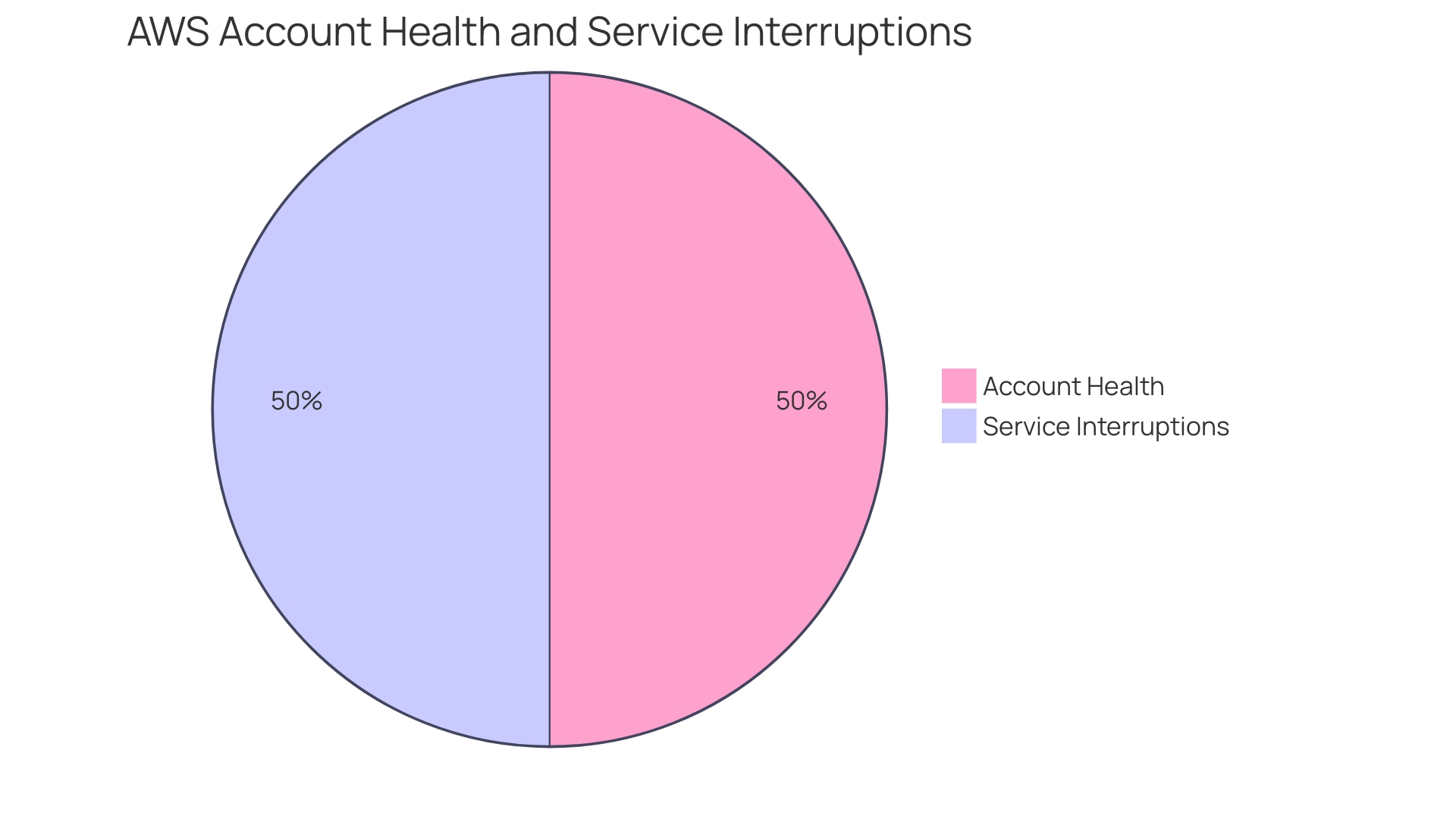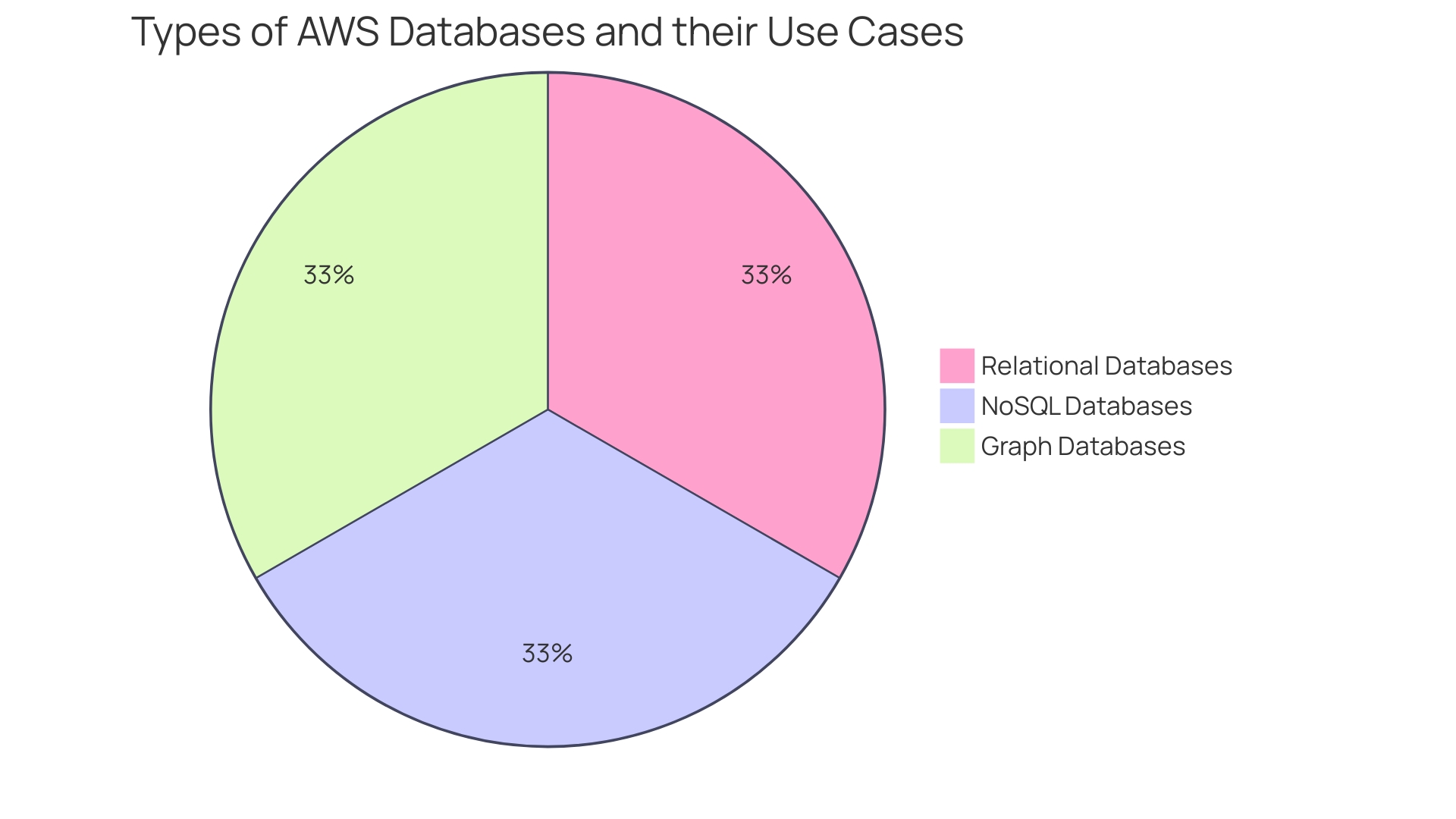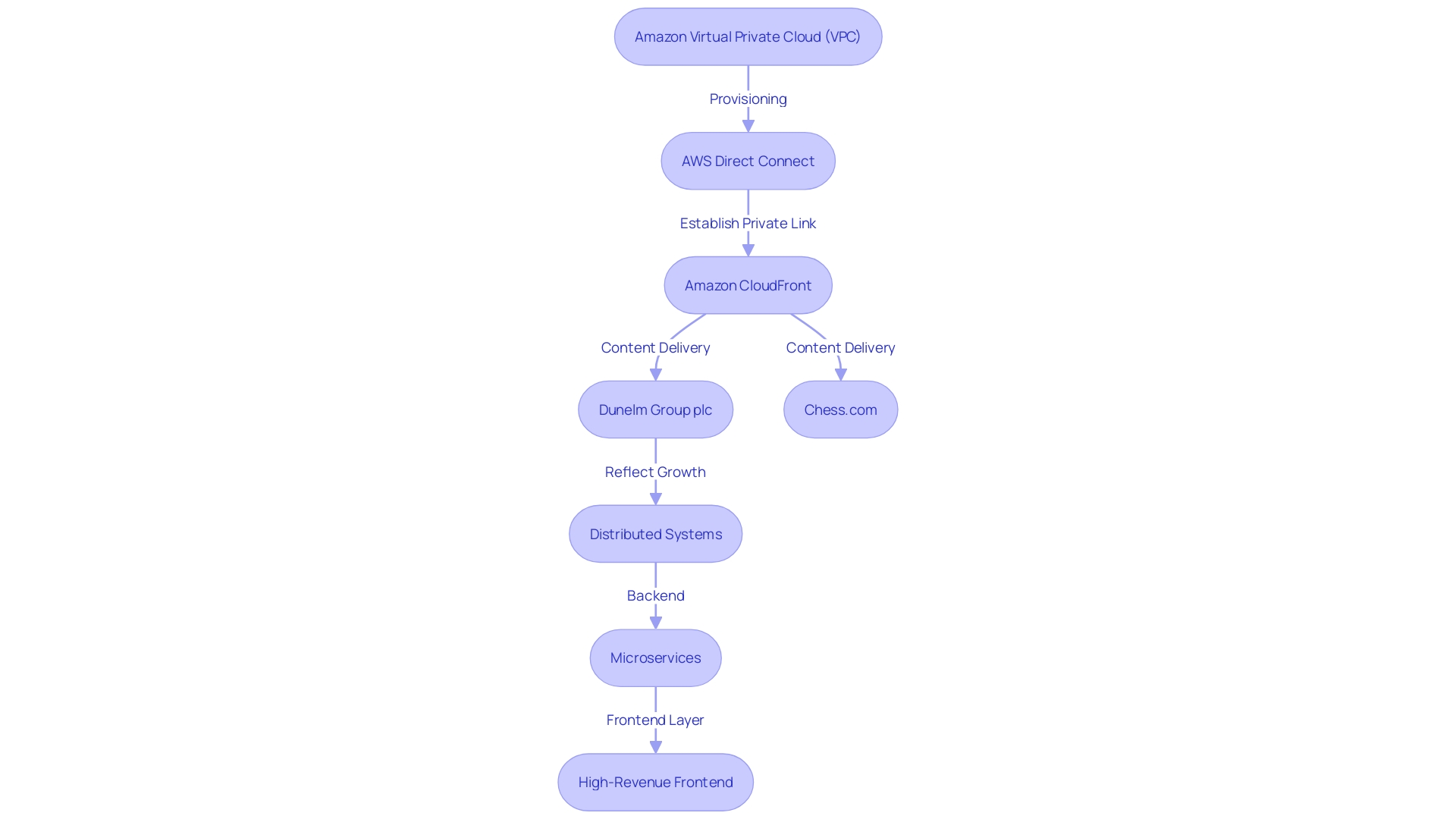Introduction
The history and evolution of Amazon Web Services (AWS) is a testament to the transformative power of cloud computing. From its humble beginnings as an online bookstore, AWS has grown into a global powerhouse, offering over 200 comprehensive services and shaping the future of technology. This article explores the genesis of AWS, its key features and benefits, core services, and its impact on various industries.
Additionally, it delves into AWS's commitment to security and compliance, provides insights into getting started with AWS, and offers guidance on navigating the AWS Management Console. Furthermore, it discusses common challenges faced by businesses leveraging AWS and presents best practices to overcome them. Lastly, the article highlights the significance of AWS certification exams, real-world applications, and case studies that showcase the versatility and impact of AWS in driving innovation and growth.
Whether you're a beginner or a seasoned professional, this article serves as a comprehensive guide to understanding and harnessing the power of AWS.
History and Evolution of AWS
The genesis of Amazon Web Services (AWS) is rooted in a profound shift in technology, one that has reshaped the landscape of cloud computing and digital solutions. Jeff Bezos, driven by a fear of regret and a foresight of the internet's exponential growth, left his Wall Street job to start what would become a global powerhouse. The inception of AWS was not the result of a sudden epiphany but rather a strategic response to the burgeoning e-commerce space. Seattle, with its tech-rich environment, became the fertile ground for Amazon's online bookstore to burgeon into an enterprise valued at over $1.7 trillion, now employing a vast workforce worldwide.
Transformation and diversification have been hallmarks of Amazon's journey, with its expansion from online retail into arenas such as cloud services, artificial intelligence, and even autonomous vehicles. AWS, in particular, represents a significant stride, offering more than 200 comprehensive services from a network of global data centers. The analogy of Australia's diverse animal kingdom illustrates the vastness and variety of AWS's offerings, with its 'states and territories' akin to AWS regions, ensuring localized governance and specialization.
The vision for a standardized, automated infrastructure utilizing extensive web services laid out in a pivotal paper by Benjamin Black and Chris Pinkham in 2003 catalyzed the development of AWS. By 2004, an experimental project spearheaded by a dedicated team in South Africa marked the nascent stages of what would evolve into the most widely adopted cloud platform.
The impact of AWS is not only felt in the realm of e-commerce but extends to various sectors, such as drug discovery in pharmaceuticals, where Vertex Pharmaceuticals leverages machine learning for data analysis. In the automotive industry, the BMW Group relies on data-driven decision-making, where data scientists and machine learning engineers use AWS to enhance business processes and support executive choices.
These examples reflect the transformative potential of AWS, which, like the technological revolutions before it, has redefined what is considered 'modern' in business infrastructure. As a leader in cloud computing, AWS continues to shape the future of technology, proving essential for established businesses and a beacon for innovation in an ever-evolving digital world.

Key Features and Benefits of AWS
Amazon Web Services (AWS) is renowned for providing scalable, reliable, and cost-effective cloud computing solutions. Companies, from small businesses to large enterprises, leverage AWS to harness the power of cloud technology, enabling them to innovate quickly and scale efficiently. AWS's global infrastructure further ensures that businesses can deliver their services with high availability and low latency across the world.
The decision to adopt cloud services like AWS is often centered around the debate of whether to build in-house solutions or to purchase services. Mature development teams may consider creating bespoke applications if doing so doesn't expend excessive time or resources. On the other hand, many organizations find value in buying services such as Software as a Service (SaaS) applications, where AWS manages scalability and maintenance, allowing businesses to focus on their core objectives.
AWS's cloud environment supports the construction of modern, elastic workloads on cutting-edge hardware with a flexible pay-as-you-go pricing model. This flexibility has been crucial for companies like GoDaddy, which serves over 20 million customers globally. GoDaddy, a data-driven organization, has embraced AWS to enhance their batch processing jobs, applying a structured methodology to improve efficiency. This exemplifies the strategic approach many businesses take when optimizing their operations within the AWS ecosystem.
Moreover, the evolving landscape of technologies like the Internet of Things (IoT) and Artificial Intelligence (AI) presents further opportunities and challenges. With over 15 billion devices expected to double by 2030, the IoT domain is expanding, necessitating robust cloud services for device management and data processing. Similarly, the rising interest in generative AI among small and medium-sized businesses underscores the need for cloud platforms that can provide the necessary computational power and data quality.
At a time when cloud services are integral to operational success, AWS's investment of £8 billion in the UK's digital and AI infrastructure over the next five years demonstrates its commitment to supporting the digital transformation needs of its customers.
In essence, AWS's comprehensive services equip organizations with the tools they need to remain agile and competitive in a fast-paced digital economy, enabling them to adapt to the changing demands of the market and technological advancements.
Core AWS Services
Amazon Web Services (AWS) is a global powerhouse in the realm of cloud computing, offering a vast suite of services that cater to diverse business requirements. AWS stands out with its robust compute services, like the Elastic Compute Cloud (EC2), which empowers users with scalable virtual machines and serverless computing options. Container orchestration is also made seamless with tools like Kubernetes.
Storage solutions on AWS are designed to be secure, scalable, and highly available. From simple object storage with Amazon S3 to block storage for EC2 with Amazon EBS, the platform ensures that businesses have the right tools for their data storage needs.
Databases are a critical component, and AWS provides a variety of database services that support different data models, such as relational, NoSQL, and in-memory databases. This flexibility allows businesses to select the optimal storage approach for their applications.
AWS's networking services enable secure and scalable connectivity between your resources, facilitating a smooth content delivery network. This ensures fast and reliable access to applications and data globally.
Moreover, the integration of generative AI, as seen with services like Amazon Q Business, is revolutionizing how businesses interact with data. It allows for the automation of tasks such as answering questions, summarizing content, and task completion by tapping into enterprise systems like ServiceNow.
This suite of services not only provides the infrastructure for big data processing, machine learning, and data warehousing but also includes comprehensive security tools for identity and access management and encryption, enabling businesses to deploy, develop, and manage complex applications with confidence.
For small and medium-sized businesses seeking a competitive edge through innovation, AWS offers generative AI-powered tools that promise productivity boosts and customer satisfaction. With the ability to scale at their own pace, businesses find AWS to be a flexible and cost-effective solution for their IT needs.
AWS's commitment to innovation is evident in its support of organizations across various sectors. For instance, the use of AI by neonatal neurotechnology companies to identify at-risk newborns or by nonprofits to accelerate the detection of digital files related to sexual abuse showcases the transformative impact of AWS services.
As organizations continue to leverage AWS for cloud infrastructure—holding a commanding 31% market share—the platform's role in enabling technology advancements and operational efficiencies is unquestionable.

Compute Services
Amazon Web Services (AWS) delivers a suite of compute services that are foundational for businesses looking to harness the power of the cloud for running applications and handling complex workloads. At the heart of this offering is Amazon EC2, a service that provides scalable computing capacity, allowing businesses to develop and deploy applications rapidly without the need for upfront investments in hardware. AWS also offers AWS Lambda, a serverless compute service that runs code in response to events and automatically manages the underlying compute resources, making it ideal for on-demand tasks that require quick scalability.
Moreover, for those utilizing containerized applications, Amazon Elastic Container Service (ECS) provides a highly secure, reliable, and scalable way to run containers, supporting Docker containers and allowing easy integration with AWS services. These compute services cater to a variety of use cases, from machine learning projects as seen in the case of the TR Labs team, which scaled their efforts in text summarization and document categorization with AWS's robust ML capabilities, to financial technology companies like Chime, which relies on AWS's compute power to monitor fraudulent transactions and safeguard member accounts.
The versatility and comprehensive nature of AWS compute services are demonstrated by the diverse clientele they support, ranging from startups to large enterprises. The services are designed to be on-demand and scalable, resonating with the increasing demand for green computing practices by enabling optimization of resources and reducing the environmental impact of data centers. As businesses continue to move towards sustainable solutions, AWS's commitment to flexibility and affordability makes it a competitive choice for companies looking to innovate and scale efficiently in the cloud.
Storage Services
AWS's suite of cloud storage solutions, including Amazon S3, Amazon EBS, and Amazon Glacier, cater to diverse data storage requirements, ensuring robust performance and seamless data retrieval. Amazon Simple Storage Service (Amazon S3), with its industry-leading scalability, enables organizations to store and access vast amounts of data from any location or device. It excels in data availability, security, and performance, making it an ideal choice for storing a wide variety of data types.
Amazon S3's object storage model organizes data into 'buckets,' akin to folders, which simplifies the management of data regardless of its volume. The service's scalability is especially beneficial for industries such as media and entertainment, where film editing and visual effects necessitate high-performance storage for large, unstructured data sets. This adaptability is reflected in the fact that 50% of organizations in this sector have recognized the need for superior cloud storage capabilities.
In the context of the life sciences industry, where datasets are notably diverse in format and application, Amazon S3 provides a solution to manage data effectively. By facilitating the distinction between logical views and physical storage locations, Amazon S3 helps researchers organize and access data efficiently, addressing the challenge of heterogeneity within cross-functional teams.
Moreover, efficient data management extends to cost optimization. While storage costs tend to decrease per unit, the exponential growth of stored data can lead to unexpectedly high expenses if not managed prudently. Amazon S3 offers a transparent pricing model, enabling organizations to optimize storage expenses by understanding and utilizing the service wisely.
Recent developments in the cloud storage arena, such as the expansion of Everspin's EMxxLX STT-MRAM product family, demonstrate the ongoing innovation in high-density, high-performance storage solutions. These advancements are complemented by AWS's services, which are poised to support the upcoming surge in generative AI adoption, with 92% of organizations planning to implement generative AI within the next year.
In summary, AWS provides a powerful, secure, and cost-effective range of storage services that accommodate the intricacies of different industries, from the rapidly scaling data needs in media to the complex datasets in life sciences, ensuring that organizations can access the data they need with ease and efficiency.
Database Services
Amazon Web Services (AWS) provides an extensive array of database services that cater to a broad spectrum of data management needs for modern applications. Key offerings include Amazon RDS for managed relational databases, Amazon DynamoDB for high-performance NoSQL requirements, and Amazon Redshift for powerful data warehousing.
Amazon RDS simplifies the setup, operation, and scaling of a relational database, offering cost-efficient and resizable capacity while automating time-consuming administration tasks such as hardware provisioning, database setup, patching, and backups. It is optimized for memory, performance, or I/O, and gives you access to the capabilities of a familiar MySQL, MariaDB, Oracle, SQL Server, or PostgreSQL database engine.
For those requiring high throughput and flexible NoSQL data models, Amazon DynamoDB is a stellar choice. It can handle more than 10 trillion requests per day and support peaks of more than 20 million requests per second. Such capability is crucial for mobile, web, gaming, ad tech, IoT, and many other applications. DynamoDB is designed to let you offload the administrative burdens of operating and scaling a highly available distributed database cluster, while only paying for what you use.
In scenarios where complex queries and data analysis are required, Amazon Redshift offers a fast, fully managed data warehouse that can handle petabytes of data. Redshift provides a query engine that allows users to perform SQL queries across their data lakes, operational databases, and data warehouses.
Real-world applications of these services are abundant. Take the example of a global e-commerce platform that leverages AWS database services to manage user information, product inventory, and customer reviews efficiently. The scalability of AWS allows such platforms to handle vast amounts of data and serve millions of users simultaneously.
Dr. Swami Sivasubramanian, vice president of Data and Artificial Intelligence at AWS, emphasizes the importance of serverless database offerings. He notes, "Data is the cornerstone of every organization's digital transformation," and the serverless options available within AWS's ecosystem are designed to support the most demanding workloads, scaling to millions of transactions per second, with the flexibility to adjust workload patterns for performance and cost optimization.
By integrating these database solutions, organizations can create a robust data management strategy, scaling as needed and ensuring their applications are always supported by the best-suited database services from AWS.

Networking and Content Delivery Services
Amazon Web Services (AWS) is at the forefront of empowering businesses with the ability to create sophisticated network architectures that are both secure and scalable. Leveraging AWS's powerful networking services, companies like Dunelm Group plc have successfully scaled their digital platforms. For instance, Dunelm's digital presence, accounting for approximately 35% of their revenue, necessitated an infrastructure capable of supporting over 400 million sessions annually. AWS's networking services, such as Amazon Virtual Private Cloud (VPC), Amazon CloudFront, and Amazon Route 53, provide the backbone for such robust network performance.
Amazon VPC offers a logically isolated section of the AWS Cloud where resources can run in a network defined by the user. It allows businesses to have complete control over their virtual networking environment, including IP address ranges, subnets, route tables, and network gateways. This control is vital for companies that require a secure, scalable, and highly available architecture, especially for e-commerce platforms aiming to serve markets with low-latency demands, like a new portal for customers in Africa.
Complementing Amazon VPC, Amazon CloudFront is a content delivery service that securely delivers data, videos, applications, and APIs to customers globally with low latency and high transfer speeds. CloudFront is integrated with AWS – both physical locations that are directly connected to the AWS global infrastructure, as well as other AWS services. CloudFront works seamlessly with services including AWS Shield for DDoS mitigation, Amazon S3, Elastic Load Balancing, or Amazon EC2 as origins for your applications.
Furthermore, Amazon Route 53 effectively connects user requests to infrastructure running in AWS, such as Amazon EC2 instances, Elastic Load Balancing load balancers, or Amazon S3 buckets, and can also be used to route users to infrastructure outside of AWS. This service provides businesses with a highly available and scalable cloud Domain Name System (DNS) web service, which is essential for maintaining the availability and reliability of their digital platforms.
These services are backed by AWS's comprehensive services and robust documentation, enabling IT professionals to build systems that are reliable, secure, efficient, cost-effective, and sustainable. As the market leader in cloud services, AWS continues to innovate, helping businesses like Alianza modernize telecom infrastructure and improve customer experience by migrating workloads to a cloud environment.
The partnership between AWS and Alianza exemplifies how cloud infrastructure can reduce operational complexity and cost while unlocking new features and innovation. This collaboration aims to transform business models and enable the delivery of advanced communications services, leveraging AWS's comprehensive SaaS solution for CSPs to drive product innovation and market agility.

Security and Compliance
For enterprises leveraging cloud services, the safeguarding of sensitive data and compliance with industry regulations are paramount. Amazon Web Services (AWS) proffers an extensive array of security services that cater to these needs, creating a fortified bastion for corporate data in the cloud. With the design of AWS Identity and Access Management (IAM), AWS Key Management Service (KMS), and AWS CloudTrail, businesses are endowed with the tools necessary to craft a secure and compliant cloud-based infrastructure.
IAM is the cornerstone of AWS security, allowing for meticulous control over who is authenticated and authorized to use the resources. By defining and managing user access to AWS services and resources, companies can ensure that only legitimate users have access to sensitive data. For instance, Chime Financial, a technology-driven banking company, relies heavily on robust security measures to safeguard against unauthorized transactions, highlighting the critical nature of precise identity and access management.
Similarly, KMS is instrumental in managing cryptographic keys for your organization. It integrates with other AWS services to make encryption easier, thereby fortifying data protection. This service is vital for companies like Chess.com, with a global user base and the massive responsibility of securing user data across millions of daily interactions on its platform.
Furthermore, AWS CloudTrail is an indispensable service that provides a comprehensive log of all user activities and API usage. This enables continuous monitoring and auditing capabilities, allowing businesses to detect anomalous activities and swiftly react to potential security incidents.
These AWS services embody the evolution of cybersecurity, aligning with the industry's progression from basic network and endpoint security to sophisticated, behavior-based detection systems. As the cloud landscape expands, the importance of airtight security measures and reliable audit trails becomes even more pronounced. With AWS, organizations can navigate the complexities of cloud security, ensuring their data is shielded from unauthorized access, loss, and theft while maintaining compliance with regulatory standards.

Getting Started with AWS
Amazon Web Services (AWS) is a comprehensive ecosystem of cloud computing solutions, designed to meet the diverse needs of businesses and individuals alike. With a market-leading position and a share that's highly coveted in the job market, AWS provides a robust suite of over 300 services, encompassing computing, storage, databases, analytics, and beyond. This platform facilitates on-demand, scalable access to IT resources through the internet, eliminating the need for physical infrastructure investment and maintenance.
For those embarking on the AWS journey, the platform offers an extensive array of services. This includes virtual machines for a variety of workloads, serverless computing options for greater efficiency, and container orchestration systems like Kubernetes to simplify application deployment and scaling. AWS also places a strong emphasis on security, providing tools for identity and access management, encryption, and comprehensive safeguards for your digital assets.
Moreover, AWS's commitment to documentation and learning resources makes it an accessible entry point for beginners while still offering depth for seasoned professionals. A testament to its utility and reach, AWS has been integral in deploying impactful projects such as the OWASP Juice Shop on AWS ECS, which serves as a rich learning experience in modern application deployment and security.
With AWS's continuous innovation, as showcased at events like AWS re: Invent, the platform remains at the forefront of emerging technologies such as generative AI. Utilizing AWS, organizations are able to drive forward projects with significant social impact, like using AI to identify infants at risk of birth-related brain injuries or leveraging machine learning to combat environmental and societal challenges.
In summary, AWS stands as a pioneering force in cloud computing, offering an array of on-demand services that are both cost-effective and expansive, allowing users to build, deploy, and scale applications with ease and precision.

Navigating the AWS Management Console
Navigating the AWS Management Console is akin to steering through the command center of your cloud infrastructure. With a plethora of services at your fingertips, finding the exact tool you need is crucial. To expedite this process, AWS provides a Services dropdown menu at the top left corner, where services are neatly categorized for easy access. Alternatively, a quick search in the search bar can lead you directly to your desired service, especially when the service name is known to you.
As you manage AWS resources, it's imperative to consider best practices such as utilizing encryption to safeguard your data, a standard upheld by industry leaders such as State Street Corporation. State Street harnessed AWS Observability Services to unify their complex, multi-tenant AWS environment, streamlining management and reducing overhead. Similarly, for IoT applications, a fully managed service like Amazon Managed Grafana offers comprehensive monitoring across thousands of devices, simplifying the oversight of device health and performance.
AWS events, like the AWS Innovate Online, offer collaborative challenges across various technical domains, including security, serverless, AI/ML, and analytics. Such events provide an excellent opportunity to deepen your understanding of AWS offerings and engage with the community. With the increasing adoption of cloud services across industries, with 62% favoring AWS according to recent surveys, staying abreast of the latest AWS developments and best practices is a strategic priority.
Leveraging AWS's robust platform, organizations are driving innovation by employing AI and ML to tackle complex problems. For instance, neonatal neurotechnology companies are using AI to detect birth-related brain injuries in infants, while ML tools are being utilized for environmental monitoring and safeguarding against digital exploitation. These applications not only demonstrate the versatility of AWS services but also underscore the importance of a well-managed and navigable AWS Management Console.

Hands-On Experience with AWS Free Tier
Amazon Web Services (AWS) provides a vast array of cloud computing services, ranging from virtual servers to storage solutions. A standout feature for developers and organizations is the AWS Free Tier, designed to enable hands-on experience with AWS's platform without incurring costs. This exploratory phase is crucial for users to experiment with various AWS services, such as launching an EC2 instance or creating an S3 bucket, which offers industry-leading scalability and performance. Furthermore, deploying a basic web application on AWS can serve as a practical introduction to cloud-based solutions.
AWS's market leadership and extensive service offerings make it an essential skill in the technology industry. Access to AWS's Free Tier not only facilitates learning but also provides an opportunity to build and deploy a complete, production-like environment. This includes utilizing services like VPC for networking, ECS for container management, and IAM for security, all supported by robust documentation.
The practical application of AWS services can be seen in real-world challenges, such as the Cloud Resume Challenge, which encourages participants to gain hands-on experience with AWS. This challenge underscores the importance of AWS in preparing for a career in the cloud industry, with participants showcasing their skills by deploying actual projects, like websites, and sharing their code repositories.
Moreover, AWS's recent advancements in generative AI with Alexa highlight the platform's commitment to innovation. The new AI model optimized for voice interactions is set to enhance smart home experiences, indicating the forward-thinking nature of AWS's services.
As organizations debate between building solutions in-house or purchasing services, AWS stands out for its capabilities to support highly scalable and elastic workloads on modern hardware with a pay-as-you-go pricing model. The cloud's efficiency in running applications and the shift from managing servers to consuming services is compelling, albeit with a learning curve.
The Free Tier serves as an entry point for developers and businesses to experiment with AWS's comprehensive suite of services, offering a glimpse into the potential for scaling and innovation. Whether for learning, building, or deploying, AWS's Free Tier is a valuable resource for anyone looking to delve into cloud computing.

Common Challenges and Best Practices
Navigating the complexities of cloud computing is a multifaceted challenge that demands a strategic approach to ensure performance, cost-efficiency, and security. Businesses leveraging Amazon Web Services (AWS) must confront these challenges head-on to harness the full potential of cloud technology. By examining case studies from industry leaders, we can extract valuable insights and best practices. For instance, Chime Financial emphasizes the importance of safeguarding customer transactions, illustrating the critical role of security in maintaining trust and compliance. Similarly, GoDaddy's experience with optimizing batch processing jobs through a structured methodology underscores the need for continuous improvement in performance.
The strategy of conducting a Well-Architected review serves as a foundation for addressing these challenges. It involves a deep dive into key focus areas from a technical standpoint, which is essential for businesses to evaluate their current infrastructure and identify opportunities for enhancement. For example, the Performance Efficiency pillar of the Well-Architected Framework offers a guideline for optimizing computing resources to achieve better output.
In the realm of cost optimization, a continuous process of refinement is imperative. Understanding the nuances of financial management, resource provisioning, data handling, and cost monitoring is vital for organizations to minimize expenses while maximizing their return on investment. Each phase of a project presents unique cost considerations, and a thorough understanding of these aspects can lead to significant savings.
Moreover, adopting a mindset shift towards transformation is equally important. As highlighted by successful public sector initiatives in the UK, Singapore, and Israel, finding and retaining top tech talent is critical. These examples demonstrate how a comprehensive strategy that goes beyond technology can lead to transformative outcomes.
Businesses must also weigh the decision between building in-house solutions versus purchasing services. The cloud's capability to support modern, scalable, and elastic workloads with a pay-as-you-go model presents an attractive proposition, particularly when it comes to the latest hardware and service scalability. Nonetheless, for organizations with legacy systems or specific regulatory requirements, an on-premise approach may be more appropriate.
In conclusion, businesses utilizing AWS can draw from these insights and strategies to overcome common challenges, ensuring that their technology investments are well-aligned with their strategic goals, leading to innovation and growth.

Preparing for AWS Certification Exams
Amazon Web Services (AWS) certification exams serve as a benchmark to recognize proficiency and expertise in cloud computing. These certifications are designed to validate one’s skills and knowledge, paving the way for professional advancement. As you consider embarking on this path, it's crucial to adopt a strategic approach to your preparation.
A key tactic is setting clear milestones. Determine the date by which you want to complete your studies, and even better, schedule your exam. This creates a sense of urgency and helps structure your learning plan. Consistency is also essential; once you've selected a learning path, it's important to stick with it. Amid numerous resources and varying advice, maintaining focus on your chosen strategy prevents confusion and keeps you on track.
The importance of hands-on practice cannot be overstated. Real-world experience is invaluable in mastering AWS services, as echoed by industry professionals who emphasize building a strong foundation through practical application. One individual planning to take the Machine Learning Specialty exam prioritizes enhancing their data engineering skills by engaging in hands-on projects, rather than just studying to pass the exam.
To support this practical experience, current statistics highlight the growing demand for cloud expertise. Certifications focusing on cloud computing and cybersecurity are commanding higher salaries due to their increasing relevance in today's technology landscape. For instance, Google Cloud’s Professional Cloud Architect certification has been at the forefront of this trend, reflecting the industry's trust in certified professionals to manage critical cloud infrastructures.
In preparation for AWS certification exams, it's beneficial to keep abreast of the latest developments in cloud technology. This continual learning process ensures that once certified, you're well-equipped to tackle current and future challenges in the cloud domain. As one professional put it, earning the certification is just the beginning of your AWS journey, so stay informed, practice diligently, and leverage the certification as a stepping stone to further your expertise in AWS.

Real-World Applications and Case Studies
Amazon Web Services (AWS) has become a cornerstone for businesses seeking to innovate, enhance operational efficiency, and drive growth. For instance, the industrial manufacturing sector, amidst its evolution toward more agile and sustainable operations, faces the challenge of standardizing legacy Operational Technology (OT) systems and managing data in 'brownfield' environments. ICL, a multinational manufacturing and mining corporation, encountered such challenges with their heavy machinery in extreme conditions, which traditionally relied on manual monitoring—an approach that was neither scalable nor cost-effective.
In the legal sector, companies like Thomson Reuters, serving professionals in fields such as law, tax, and compliance, require error-free legal research underpinned by decades of curated editorial content. The need for accuracy and completeness in these domains is non-negotiable. Similarly, Schneider Electric, a leader in energy management and industrial automation, must navigate the complex task of merging disparate ERP systems to effectively track customer accounts as their base expands.
Chime Financial, a fintech company committed to member-first financial products, shoulders the responsibility of safeguarding against unauthorized transactions. Like many other businesses, Chime is driven by the need for innovation, inclusion, and access within the industry.
GoDaddy, serving over 20 million customers globally, emphasizes its data-driven approach to optimizing batch processing jobs. Their structured methodology, known as the seven layers of improvement opportunities, guides their pursuit of efficiency.
These examples illustrate not just the diversity of challenges faced by various industries but also the versatility of AWS in providing tailored solutions. From IoT devices, which are projected to double in number by 2030, to data-intensive tasks, AWS plays a crucial role in enabling companies to overcome hurdles, comply with regulations, and make real-time decisions, all while reducing operational costs.
Conclusion
In conclusion, Amazon Web Services (AWS) has revolutionized cloud computing, offering a wide range of services that empower businesses to innovate and scale with ease. With a strong focus on security and compliance, AWS provides reliable and cost-effective solutions that meet the diverse needs of organizations worldwide.
AWS's core services, such as EC2, Amazon S3, and Amazon RDS, cater to various business requirements, delivering modern and secure workloads. The networking and content delivery services, including Amazon VPC and CloudFront, ensure seamless connectivity and global accessibility.
Navigating the AWS Management Console is intuitive, with user-friendly features that simplify the process. By following best practices, such as encryption and conducting Well-Architected reviews, businesses can optimize performance, cost-efficiency, and security.
Common challenges faced by AWS users, such as security, performance optimization, and cost management, can be effectively addressed with strategic approaches and best practices. AWS certification exams provide professionals with an opportunity to validate their expertise and advance their careers in cloud computing.
Real-world applications and case studies across industries demonstrate the versatility and impact of AWS in driving innovation, enhancing operational efficiency, and achieving growth. With continuous innovation and a commitment to supporting businesses in the digital economy, AWS remains a trusted and leading provider of cloud computing solutions.
In conclusion, AWS is a reliable and comprehensive ecosystem that empowers organizations to succeed in the ever-evolving digital landscape. By leveraging its robust services and adhering to best practices, businesses can harness the transformative power of AWS to drive innovation, scalability, and success.




